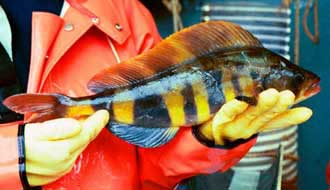 September 10, 2003
"We're finding out if commercial fishing impacts the movement and local abundance of Atka mackerel and if the trawl exclusion zones do their job in keeping prey fish such as Atka mackerel protected and available for Steller sea lions to feed on," explained Dr. Doug DeMaster, Administrator of the Alaska Fisheries Science Center. "When we better understand fishing impacts on fish behavior, we'll have a better basis for designing protections for Steller sea lion prey." "The data so far appear to indicate that the no-trawl zones are working," said DeMaster. This summer, six researchers from NOAA Fisheries charted the Pacific Explorer, which departed Dutch Harbor in mid-July for a two-week research cruise. In eight days roughly 15,000 Atka mackerel were tagged and released inside and outside the trawl exclusion zones near Amchitka Island, according to team leader and fish biologist Libby Logerwell. Fishermen return tagged fish to NOAA Fisheries observers on board commercial factory trawlers and receive token rewards such as hats, T-shirts, and coffee mugs in exchange. "We've had over 330 tagged Atka mackerel returned in the four years of the study," said Logerwell. "Fishermen and fishery observers have cooperated and we appreciate it. The success of the study relies on these returns." Results to date suggest that there is relatively little movement of Atka mackerel from inside to outside the trawl exclusion zones near Steller sea lion rookeries around Seguam and Tanaga passes, an indicator that the trawl exclusion zones are effective at protecting Atka mackerel, a common Steller sea lion meal. However, researchers caution that the results from these particular locations may not apply in other areas, each with resident Atka mackerel populations and fisheries of different size and distribution. While Steller sea lions appear to be doing well in the waters off Oregon, Washington, British Columbia and southeast Alaska, they have declined sharply in the Aleutian Islands, and are listed as endangered under the Endangered Species Act. The decline of Steller sea lions in the Aleutians remain mysterious. NOAA Fisheries drew no-trawling zones 20 nautical miles wide around six sea lion rookeries in the eastern Aleutians in 1991 in an attempt to reduce any competition for the Steller sea lion's prey in those areas. In 1998, NOAA Fisheries spread the fishing out through time: instead of one season per year for Atka mackerel, managers mandated two seasons and assigned more quota to be caught outside of critical habitat. These restrictions severely affected commercial fishing. Fishermen questioned both the effectiveness of the no-trawl zones and the presumed impact of the fishery on Atka mackerel. Atka mackerel comprise one of the largest fish biomasses in the Aleutian archipelago, with current estimates of 500,000 tons. Atka mackerel seem to prefer strong currents: they aggregate in Aleutian island ocean passes, and have been observed at great densities. However, their locality is hard to predict at any given time. In summer 2000, researchers released approximately 800 tagged Atka mackerel in Seguam Pass, plus another 1000 in 2001. In 2002 around 21,000 were tagged and released in Seguam Pass, and another 14,500 near Tanaga Pass. In 2003 they released 15,000 near Amchitka Island. NOAA Fisheries scientists plan to begin parallel tag release-recovery studies at other sites in the western Aleutians such as Kiska, Buldir, Agattu or Attu in 2004. Fishermen and federal observers on fishing boats recover the tagged fish in the areas open to fishing. Chartered recovery cruises catch tagged fish in the closed areas. Researchers plan for the Atka mackerel study to continue for at least another three to five years. The researchers are part of the Alaska Fisheries Science Center's Fisheries Interaction Team which is also studying Pacific cod and walleye pollock to determine whether commercial fishing operations impact the foraging success of sea lions either through disturbance of prey schools or through direct competition for a common prey.
|
||
